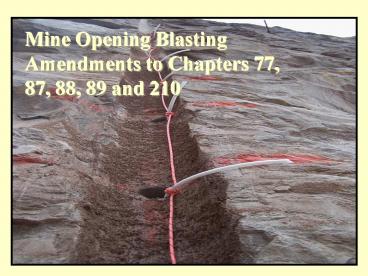ShaftEntry Blasting Regulations - PowerPoint PPT Presentation
1 / 21
Title: ShaftEntry Blasting Regulations
1
Mine Opening Blasting Amendments to Chapters 77,
87, 88, 89 and 210
2
Background
- Mine Opening Blasting is
- blasting to develop shafts, slopes or other
entries to an underground mine. - surface blasting activity until the entry reaches
the mineral being mined. - blasting that is close enough to the surface to
expose the public to adverse effects such as
flyrock, airblast (vibrations traveling through
the air) or ground vibration.
3
Background
- Public risk from flyrock is higher from the first
2 blasts. - Subsequent blasting (typically, another 10 to 100
blasts) is less likely to pose a risk to the
public from flyrock, and ground vibration levels
should also decrease. - Airblast levels can persist even at substantial
depths.
4
Background
- Dual enforcement duties between District Mining
Offices (DMOs) and the Bureau of Mine Safety
(BMS) - created confusion that led to surface blasting
performance standards not being applied. - This gap in the application of the regulation,
coupled with industry concern for consistency,
led to the need to develop regulations.
5
(No Transcript)
6
(No Transcript)
7
(No Transcript)
8
(No Transcript)
9
(No Transcript)
10
The Need for New Regulations
- Entry blasting is surface blasting in the surface
mining regulations. - Current regulations dont consider the
differences between entry blasting and surface
blasting. - Those differences are significant enough to
necessitate regulatory changes.
11
Regulatory Changes
- Allow entry blasting to occur, after the first
- two blasts, any time day or night.
- This change provides for continuous development
that is necessary to protect the workers in the
shaft from unstable shaft walls. - After the initial 2 blasts the blasting is being
conducted deep enough in the ground that the risk
to the public from flyrock is sufficiently
diminished to safely allow for blasting after
dark.
12
Regulatory Changes
- Allow blasting within 800 feet of highways as
- long as sufficient precautions are taken.
- This change provides consistency for all blasting
operations in Pennsylvania, with respect to the
distance blasting is allowed to occur to
highways. - Typically, precautions such as better blast
designs protect the motoring public more
effectively than alternative methods. - Stopping traffic on a busy highway can increase
the risk of a serious traffic accident.
13
Regulatory Changes
- Require that entry blasting be conducted by a
person with a blasters license that is specific
to entry blasting. - A blasters license category for entry blasting
will require specialized training and examination
that focuses on both the underground and surface
aspects of entry blasting.
14
Changes Made In Response to Prior Oversight
- specify that blast records include the identity
of the dwelling or other structure closest to the
blasting, as well as the distance and direction. - specify that required seismograph records must be
attached to blast records.
15
MRAB Meetings
- General agreement on many sections
- August 15, 2005
- October 27, 2005
- January 5, 2006
- However, at the January 5, 2006 meeting, the MRAB
deadlocked on whether mine opening construction
is a surface mining activity.
16
Changes Made In Response to Comments
- A commentator observed that the use of the term
vibration limits was unclear. - The term has been changed to ground vibration
and airblast limits.
17
Change Made For Accuracy
- The term airblast has replaced noise or
- sound.
- The terms noise and sound indicate something
heard by humans. Airblast often results in
concussive, wave energy traveling through the air
having a frequency of less than 20 Hz, which
can't be heard by humans. - Noise or sound are no longer used to describe
airblast, as they do not do so accurately.
18
MRAB Meetings
- The MRAB reviewed the final rulemaking at the
January 25, 2007 meeting. It recommend
disapproval based on the position that mine
opening construction is not a surface mining
activity. - Department disagrees with this interpretation and
recommends the Board approve this final
rulemaking.
19
DEPs Statutory Authority
- SMCRA definition of surface mining activity
- strip, auger mining, dredging, quarrying and
leaching, and all surface activity connected with
surface or underground mining, including, but not
limited to, exploration, site preparation, entry,
tunnel, drift, slope, shaft and borehole drilling
and construction
20
DEPs Perspective
- Mine opening construction occurs in proximity to
inhabited areas. - Department receives complaints about the effects
of the related blasting activity during the
construction of the entire opening (to the coal
seam or mineral being mined). - Applying surface mining blasting regulations to
the construction of the entire mine opening is
necessary because it limits airblast and ground
vibration and prohibits the flyrock that
potentially could result from the blasting.
21
Thank You!
J. Scott Roberts Deputy Secretary, Mineral
Resources Joe Pizarchik Bureau Director, Mining
and Reclamation William Allen Division Chief,
Monitoring and Compliance Marc Roda Legal
Counsel































